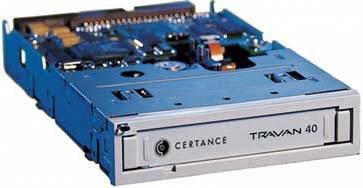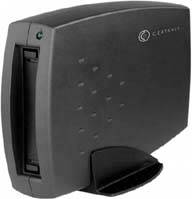9.6. Tape Drives Although corporate data centers still use tape drives for backing up, tape drives are no longer a mainstream technology for home and small business PCs, if indeed they ever were. For corporations, the advantages of high-end tape drivesextreme reliability, robust error detection and correction, high capacity, and speedoutweigh the disadvantages. For homes and small businesses, the disadvantages of consumer-grade tape driveslow capacity and speed, high cost, and the physical fragility of the tapesoutweigh the advantages. Consumer-grade tape drives have always lagged behind hard drives in capacity, and that gap remains today. The highest-capacity consumer-grade tape drives, Travan 40 models, store only 20 GB natively, although they are advertised as storing 40 GB with compression. (Realistically, you can expect to store about 30 GB on a "40 GB" tape, less for incompressible data, such as image files.) Consumer-grade tape drives use the ATA or USB 2.0 interfaceso even the internal models are as easy to install as an optical drivebut they require many hours to write and verify a tape. Also, tapes are quite expensive, at $30 to $40 each, which translates to a media cost of $1/GB or more. Figures 9-6 and 9-7 show Certance Travan 40 tape drives, internal and external models, respectively. Figure 9-6. Certance Travan 40 internal tape drive (image courtesy of Certance LLC) 
Figure 9-7. Certance Travan 40 external tape drive (image courtesy of Certance LLC) 
If you are considering buying a tape driveor if you currently use one for backupconsider the following: If your working data setwith or without compressionfits on one DVD, we recommend using a DVD writer with DVD+R or DVD+RW discs. (That's what we use for our own backups, after years of using tape drives.) DVD writers are much faster than tape. Backing up and verifying 4,400 MB to a DVD+R disc takes only a few minutes, versus an hour or more to back up and verify the same amount of data to a consumer-grade tape drive. If 4,400 MB isn't quite enough, you can use DVD+R/DL dual-layer discs, which store up to 8,500 MB. Although optical discs have less robust error detection and correction than tape drives, that problem is easily solved by making more frequent backups and keeping older backup discs for redundancy. Media costs range from $0.05/GB to $0.50/GB, depending on the media you use. | Proprietary Removable Storage Systems | Over the years, many companies have tried and failed miserably to develop a market for proprietary external or removable storage systems. The most successful of the bunchthe Iomega ZIP and Jaz driveswere never more than niche products, and are now merely footnotes in computer history. Other products, such as the LS-120 highcapacity floppy drive and cartridge-based storage systems from SyQuest, Castlewood, and others, sold in small numbers and are long obsolete. The problem with most of these products was that their makers attempted to use the King Gillette scheme of giving away the razor and selling the blades. Accordingly, these companies sold their drives at a low priceoften below their costexpecting to recoup their investment by selling lots of high-profit disk cartridges. Alas, users never bought as many disk cartridges as the manufacturers thought they would, so, with the exception of Iomega, most of these companies have disappeared. If you are still using one of these obsolete drives, do yourself a favor. Get your data off the proprietary disk cartridges while you still can and write it to your hard drive or optical discs. Then, do a favor for a stranger. Sell the drive on eBay so that someone else who has a nonfunctioning drive and a bunch of disks can salvage his data. |
| ONE CENT PER GIGABYTE? | The cost/capacity equation will change as high-capacity Blu-Ray and HD-DVD writers become mainstream products, which we don't expect to occur until at least mid-2007. Although Blu-Ray and HD-DVD drives and discs will be very expensive initially, we expect eventually to see 50 GB writable optical discs selling for $0.50 apiece. Of course, by that time we'll probably all have a terabyte or more of hard disk storage in our systems. |
If your working data set is too large for one DVD, we recommend using full-size external hard drives or a frame/carrier removable hard drive system for backup. Depending on the number and type of files to be backed up, real-world throughput may be 30 GB/hour or more, which makes it practical to back up and verify large data sets even if your backup window is short. Hard drives have less robust error detection and correction than tape drives, but again that problem is easily solved by using redundancy. Media costs are roughly $1/GB, depending on the size and type of external or removable hard drive you choose.
| FUNNY-LOOKING TAPES | For the same cost as a consumer-grade tape drive and enough tapes to implement a reasonable rotation, you can buy three or four external hard drives that are specifically designed for backing up. These drivessold by Seagate, Maxtor, Western Digital, Fantom, and othersinclude backup software such as Dantz Retrospect, which allows you to back up your system by pressing one button. The size of your backup set is limited only by the total capacity of the external hard drive, and multiple backup sets can be written to the drive until its capacity is reached. Whatever you do, don't buy just one external hard drive for backup. If you have only one backup drive, Murphy's Law predicts that when your internal hard drive fails, you'll somehow break the external hard drive as well. Use at least two external hard drives for backup, and alternate backups between them. |
|

